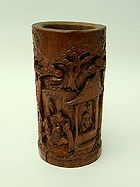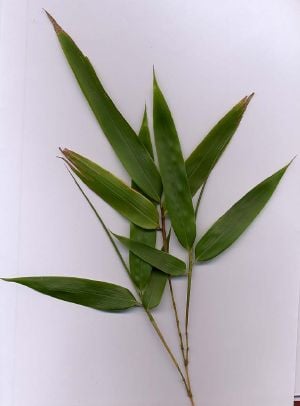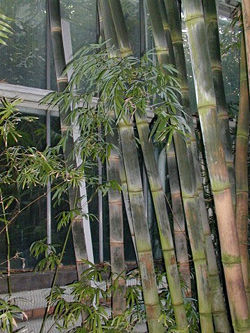Difference between revisions of "Bamboo" - New World Encyclopedia
({{Paid}}) |
Glenn Strait (talk | contribs) |
||
| Line 1: | Line 1: | ||
| − | {{Approved}}{{Images OK}}{{Submitted}}{{Claimed}}{{Contracted}}{{Paid}} | + | {{Edboard}}{{Approved}}{{Images OK}}{{Submitted}}{{Claimed}}{{Contracted}}{{Paid}} |
{{Taxobox | {{Taxobox | ||
| color = lightgreen | | color = lightgreen | ||
| Line 31: | Line 31: | ||
}} | }} | ||
| − | '''Bamboo''' | + | '''Bamboo''' comprises more than 1200 species of usually [[wood]]y [[perennial plant|perennial]] [[plant]]s in the true grass family '''[[Poaceae]]''' occurring primarily in tropical, subtropical, and temperate regions in Asia, Africa, and the Americas. Bamboo are distributed among more than 90 genera in the subfamily [[Bambusoideae]] and the tribe '''Bambuseae'''. The term also is used for the woody stems of these grasses, which have commercial value. |
| − | Unlike most [[grass]]es, bamboos can grow very tall, with some members | + | Unlike most [[grass]]es, bamboos can grow very tall, with some members reaching heights of up to 30 meters (98 feet). |
| − | In addition to offering various values to the [[ecosystem]], such as food for the giant panda or [[insect]] [[larva]]e, bamboo offers culinary, medicinal, construction, artistic, and ornamental values to human beings. The shoots of bamboo are used in numerous Asian dishes and broths, and are available in supermarkets in various sliced forms, both fresh and canned. Pickled bamboo is used as a condiment and the sap of young stalks may be fermented to make a sweet wine or used to make a soft drink. | + | In addition to offering various values to the [[ecosystem]], such as food for the giant panda or [[insect]] [[larva]]e, bamboo offers culinary, medicinal, construction, artistic, and ornamental values to human beings. The shoots of bamboo are used in numerous Asian dishes and broths, and are available in supermarkets in various sliced forms, both fresh and canned. Pickled bamboo is used as a condiment and the sap of young stalks may be fermented to make a sweet wine or used to make a soft drink. Bamboo is used in Chinese medicine for treating infections and as a low calorie source of [[potassium]]. When properly processed and treated, bamboo forms a very hard, tough, and yet light wood, useful in house construction, as well as for fences, bridges, toilets, furniture, and numerous other purposes, including making various musical instruments. Bamboo also is widely carved for decorative artwork and the fiber of bamboo has been used since early times to make [[paper]] in [[China]]. Bamboo is also popular as an ornamental plant in gardens. |
| − | Bamboo | + | Bamboo assumes symbolic meaning and value in human culture, signifying such values as longevity and friendship, and in some cultures representing the four seasons or a sacred barrier against evil. Bamboo has been used to represent eternity, tradition, or lineage, as noted in the [[Vietnam]]ese proverb, "When the bamboo is old, the bamboo sprouts appear." |
==Description== | ==Description== | ||
| − | Bamboo is a member of the grass family, Poaceae | + | Bamboo is a member of the grass family, Poaceae, which is one of the largest [[plant]] families, and to humans perhaps the most important, as this family includes agricultural grains such as wheat and rice, as well as sugar cane. There are about 600 genera and perhaps ten thousand species of grasses, which includes bamboo's more than 90 genera and more than 1200 species. |
| − | + | The tall species of bamboo are by far the largest members of the grass family, with the younger tips of some of the larger species growing more than 1 meter per day toward their ultimate height of more than 30 meters. | |
| − | |||
| − | |||
| − | |||
| − | |||
| − | |||
| − | |||
| − | |||
| − | |||
| − | |||
Most are [[tree#evergreen versus deciduous|evergreen]], but some have [[tree#evergreen versus deciduous|deciduous]] leaves. | Most are [[tree#evergreen versus deciduous|evergreen]], but some have [[tree#evergreen versus deciduous|deciduous]] leaves. | ||
| − | Bamboos | + | Bamboos spread### from cold mountains to hot [[tropical]] regions. They occur across [[East Asia]], from 50°N latitude in [[Sakhalin]] through to northern [[Australia]], and west to [[India]] and the [[Himalaya]] (Bystriakova et al. 2003). They also occur in sub-[[Sahara]]n [[Africa]], and in the [[The Americas|Americas]] from the southeast of the [[United States|USA]] south to [[Chile]], there reaching their furthest south anywhere, at 47°S latitude (USDA 2007). Major areas with no native bamboos include [[Europe]], north [[Africa]], western [[Asia]], [[Canada]], most of [[Australia]], and [[Antarctica]]. |
Soft bamboo shoots, stems, and leaves are the major food source of the [[giant panda]] of [[China]]. | Soft bamboo shoots, stems, and leaves are the major food source of the [[giant panda]] of [[China]]. | ||
Revision as of 18:56, 15 October 2007
| Bamboos | ||||||||||||||||
|---|---|---|---|---|---|---|---|---|---|---|---|---|---|---|---|---|
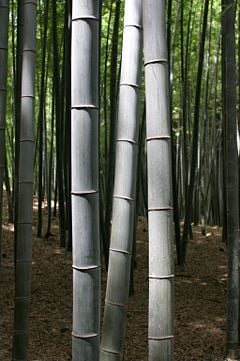 Bamboo forest in Kyoto, Japan
| ||||||||||||||||
| Scientific classification | ||||||||||||||||
| ||||||||||||||||
| Diversity | ||||||||||||||||
| Around 91 genera and 1,200 species | ||||||||||||||||
See the full Taxonomy of the Bambuseae. |
Bamboo comprises more than 1200 species of usually woody perennial plants in the true grass family Poaceae occurring primarily in tropical, subtropical, and temperate regions in Asia, Africa, and the Americas. Bamboo are distributed among more than 90 genera in the subfamily Bambusoideae and the tribe Bambuseae. The term also is used for the woody stems of these grasses, which have commercial value.
Unlike most grasses, bamboos can grow very tall, with some members reaching heights of up to 30 meters (98 feet).
In addition to offering various values to the ecosystem, such as food for the giant panda or insect larvae, bamboo offers culinary, medicinal, construction, artistic, and ornamental values to human beings. The shoots of bamboo are used in numerous Asian dishes and broths, and are available in supermarkets in various sliced forms, both fresh and canned. Pickled bamboo is used as a condiment and the sap of young stalks may be fermented to make a sweet wine or used to make a soft drink. Bamboo is used in Chinese medicine for treating infections and as a low calorie source of potassium. When properly processed and treated, bamboo forms a very hard, tough, and yet light wood, useful in house construction, as well as for fences, bridges, toilets, furniture, and numerous other purposes, including making various musical instruments. Bamboo also is widely carved for decorative artwork and the fiber of bamboo has been used since early times to make paper in China. Bamboo is also popular as an ornamental plant in gardens.
Bamboo assumes symbolic meaning and value in human culture, signifying such values as longevity and friendship, and in some cultures representing the four seasons or a sacred barrier against evil. Bamboo has been used to represent eternity, tradition, or lineage, as noted in the Vietnamese proverb, "When the bamboo is old, the bamboo sprouts appear."
Description
Bamboo is a member of the grass family, Poaceae, which is one of the largest plant families, and to humans perhaps the most important, as this family includes agricultural grains such as wheat and rice, as well as sugar cane. There are about 600 genera and perhaps ten thousand species of grasses, which includes bamboo's more than 90 genera and more than 1200 species.
The tall species of bamboo are by far the largest members of the grass family, with the younger tips of some of the larger species growing more than 1 meter per day toward their ultimate height of more than 30 meters.
Most are evergreen, but some have deciduous leaves.
Bamboos spread### from cold mountains to hot tropical regions. They occur across East Asia, from 50°N latitude in Sakhalin through to northern Australia, and west to India and the Himalaya (Bystriakova et al. 2003). They also occur in sub-Saharan Africa, and in the Americas from the southeast of the USA south to Chile, there reaching their furthest south anywhere, at 47°S latitude (USDA 2007). Major areas with no native bamboos include Europe, north Africa, western Asia, Canada, most of Australia, and Antarctica.
Soft bamboo shoots, stems, and leaves are the major food source of the giant panda of China.
Uses
Culinary
The shoots of bamboo, new bamboo culms that come out of the ground—called zhú sǔn (simplified: 竹笋; traditional: 竹筍) or simply sǔn (笋) in Chinese—are edible. They are used in numerous Asian dishes and broths, and are available in supermarkets in various sliced forms, both fresh and canned version. Bamboo shoot tips are called zhú sǔn jiān (竹笋尖) or simply sǔn jiān (笋尖).
In Indonesia, the shoots are sliced thinly and then boiled with santan (which is thick coconut milk) and spices to make a dish named gulai rebung. Other recipes using bamboo shoots are a vegetable dish mixed in coconut milk called sayur lodeh, and lun pia (sometimes written lumpia), which is fried wrapped bamboo shoots with vegetables. Note that the shoots of some species contain toxins that need to be leached or boiled out before they can be eaten safely.
Pickled bamboo, used as a condiment, may also be made from the pith of the young shoots.
The sap of young stalks tapped during the rainy season may be fermented to make a sweet wine, ulanzi, or simply made into a soft drink. Zhúyèqīng jiǔ (竹葉青酒) is a green-colored Baijiu Chinese liquor that has bamboo leaves as one of its ingredients.
Bamboo leaves also are used as wrappers for zongzi, a steamed dumpling typical of southern China, which usually contains glutinous rice and other ingredients.
The empty hollow in the stalks of larger bamboo is often used to cook food in many Asian cultures. Soups are boiled and rice is cooked in the hollows of fresh stalks of bamboo directly over a flame. As well, steamed tea is sometimes rammed into bamboo hollows to produce compressed forms of Pu-erh tea.
Bamboo has gained increasing popularity in the culinary world as a material for cutting boards, as they are hard enough to withstand years of knife abuse, yet more forgiving to the knife blade, causing less damage to the edged utensils over time.
In Sambalpur, India, the tender shoots are grated into julliens and fermented to prepare KARDI. Also synonymous with "Bamboo Shoots," the name is derieved from the Sanskrit word for Bamboo Shoot, "KARIRA." This fermented Bamboo Shoot is used in various culinary preparations, notably "Amil," a sour vegetable soup. It is also made into pan cakes using rice flour as a binding agent, along with spices and condiments to prepare a side dish in the local main meal. The shoots that has turned a little fibrous is fermented dried and grounded to sand size particles to prepare a garnish known as " Hendua." It is also cooked with tender pumpkin leaves to make Sag "Green Leaves."
Medicinal
Bamboo is used in Chinese medicine for treating infections. It is also a low calorie source of potassium. In Ayurveda, the Indian system of medicine, the silicious concretion found in the culms of the bamboo stem is called banslochan. It is known as tabashir or tawashir in Unani-Tibb, the Indo-Persian system of medicine. In English, this concretion is called "bamboo manna." This concretion is said to be a tonic for the respiratory diseases. This concretion, which was earlier obtained from Melocanna bambusoides, is very hard to get now and has been largely replaced by synthetic silcic acid. In most of the Indian literature, Bambusa arundinacea has been shown to be the source of bamboo manna (Puri 2003).
Architectural
When treated, bamboo forms a very hard wood, which is both light and exceptionally tough. In tropical climates, it is used in elements of house construction, as well as for fences, bridges, toilets, walking sticks, canoes, drinkware, furniture, chopsticks, food steamers, toys, construction scaffolding, as a substitute for steel reinforcing rods in concrete construction, hats, and martial arts weaponry, including fire arrows, flame throwers and festival rockets. Also, it is used in making abaci and various musical instruments (see below). When bamboo is harvested for wood, care is needed to select mature stems that are several years old, as first-year stems, although full size, are not fully woody and are not strong.
Artwork
Bamboo is also widely carved for decorative artwork. Modern companies are attempting to popularize bamboo flooring made of bamboo pieces steamed, flattened, glued together, finished, and cut. However, bamboo wood is easily infested by wood-boring insects unless treated with wood preservatives or kept very dry.
The fiber of bamboo has been used to make paper in China since early times. A high quality hand-made paper is still produced in small quantities. Coarse bamboo paper is still used to make Joss paper spirit money in many Chinese communities.
The wood is used for knitting needles and the fiber can be used for yarn and fabrics. Bamboo fabric is notable for its soft feel and natural antibacterial properties (Lela Designs 2007). Clothing made from bamboo fiber is popular for activities such as yoga. Bed sheets and towels made from bamboo have become luxury items. Sharpened bamboo is also traditionally used to tattoo in Japan, Hawaii, and elsewhere.
Accessories
Bamboo canes are normally round in cross-section, but square canes can be produced by forcing the new young culms to grow through a tube of square cross-section slightly smaller than the culm's natural diameter, thereby constricting the growth to the shape of the tube. Every few days the tube is removed and replaced higher up the fast-growing culm.
Bamboo also is used as a shank extension on smoking pipes. Often a bamboo shank is added as a repair when a shank is cracked with use or to repair a flaw during manufacture.
A variety of bamboo was one of about two dozen plants carried by Polynesian voyagers to provide all their needs settling new islands. In the Hawaiian Islands, among many uses, 'Ohe (bamboo) carried water, made irrigation troughs for taro terraces, was used as a traditional knife for cutting the umbilical cord of a newborn, as a stamp for dyeing bark tapa cloth, and for four hula instruments&mdas;nose flute, rattle, stamping pipes and Jew's harp.
Recreational

Some skateboard, snowboard deck manufacturers, as well as surfboard builders are beginning to use bamboo construction. It is both lighter and stronger than traditional materials and its cultivation is environmentally friendly.
Bamboo also is used to make enclosures in fish farming, where cages can be made from a wooden frame and bamboo lattices. It also is used to make the high-end lightweight fishing rods used in fly fishing.
Musical instruments
Bamboo is used in making various musical instruments, such as the dizi, xiao, shakuhachi, palendag, jinghu, and angklung. The Bamboo Organ of Las Pinas, Philippines has pipes made of bamboo culms.
In Indonesia, bamboo has been used for making various kinds of musical instruments. The most popular ones are kolintang and angklung. Especially for angklung, it is the pride and joy of the Sundanese people, and they have been safeguarding this tradition for centuries. Although, it is (in a lesser extent) also played by the Balinese, and later on spread to the neighboring countries in south east Asia.
A single shoot of bamboo can also be made into a didgeridoo, a wind instrument that is indigenous to Australia.
Cultivation and ornamental bamboos
Many bamboos are popular in cultivation as garden plants. In cultivation, care needs to be taken of their potential for invasive behavior. They spread mainly through their roots and/or rhizomes, which can spread widely underground and send off new culms to break through the surface.
There are two patterns for the spreading of bamboo, "clumping," or sympodial, and "running," or monopodial. Clumping bamboo species tend to spread underground slowly. Swimming bamboo species are highly variable in their tendency to spread; this is related to both the species and the soil and climate conditions. Some can send out runners several meters a year, while others can stay in the same general area for long periods. If neglected, they can be invasive over time and can cause problems by moving into adjacent areas. The reputation of bamboo as being highly invasive often is exaggerated, and situations where it has taken over large areas is often the result of years of untended or neglected plantings.
Once established as a grove, it is difficult to completely remove bamboo without digging up the entire network of underground rhizomes. If bamboo must be removed, an alternative to digging it up is to cut down the culms, and then repeatedly mow down new shoots as they arise, until the root system exhausts its energy supply and dies. If any leaves are allowed to photosynthesize, the bamboo survives and will keep spreading.
There are two main ways to prevent the spread of running bamboo into adjacent areas. The first method is rhizome pruning or "edging," which involves removing any rhizomes escaping the desired bamboo area. Hooks, shovels, and picks are usual tools. The rhizomes are generally very close to the surface(just under a sod layer), so, if rhizome pruning is done twice a year, it will sever most, if not all, of the new growth. Some species may be deep running (beyond typical spade depth). These are much harder to control and deeper cuts will need to be made. Regular maintenance will indicate major growth directions and locations. Once the rhizomes are cut, they should be removed. If any bamboo shoots come up outside of the bamboo area afterwards their presence indicates the precise location of the missed rhizome. The fibrous roots that radiate from the rhizomes do not grow up to be more bamboo so they stay in the ground.
The second way is by surrounding it with a physical barrier. Concrete and specially rolled HDPE plastic are usual materials. This is placed in a 60-90 cm (2-3 feet) deep ditch around the planting, and angled out at the top to direct the rhizomes to the surface. Strong rhizomes and tools can penetrate plastic barriers with relative ease, so great care must be taken. Bamboo in barriers is much more difficult to remove than free-spreading bamboo. Barriers and edging are unnecessary for clump forming bamboos. Clump forming bamboos may eventually need to have portions taken out if they get too large.
Bamboo in human culture
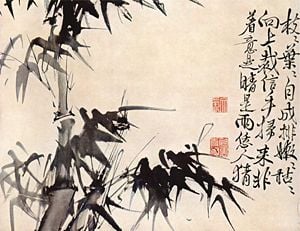
Symbolism
In Chinese culture, the bamboo (zhú 竹), plum blossom (méi 梅), orchid (lán 蘭), and chrysanthemum (jú 菊) (usually, méi lán zhú jú 梅蘭竹菊) are collectively referred to as the Four Noble Ones (四君子). These four plants also represent the four seasons and, in Confucian ideology, four aspects of the junzi (君子 "prince" or "noble one"). The pine tree (松), the bamboo, and the plum blossom (sōng zhú méi 松竹梅) are also admired for their perseverance under harsh conditions, and are together known as the "Three Friends in Winter" (歲寒三友).
Bamboo's long life makes it a Chinese symbol of longevity, while in India it is a symbol of friendship. The rarity of its blossoming has led to the flowers' being regarded as a sign of impending famine. This may be due to rats feeding upon the profusion of flowers, then multiplying and destroying a large part of the local food supply. The most recent flowering began in May 2006. Bamboo is said to bloom in this manner only about every 50 years (Huberman 1959).
In Japan, a bamboo forest sometimes surrounds a Shinto shrine as part of a sacred barrier against evil. Also, bamboo (také 竹) indicates something of the second rank, as a sushi set or accommodations at a traditional Ryokan inn. This comes from the Chinese phrase 松竹梅 (in Japanese, sho-chiku-bai), where pine (matsu 松) is of the first rank, and plum (ume 梅) is of the third.
A Vietnamese proverb says: "When the bamboo is old, the bamboo sprouts appear," the meaning being Vietnam will never be annihilated; if the previous generation dies, the children take their place. Therefore the Vietnamese tradition will be maintained and developed eternally.
Myths and legends
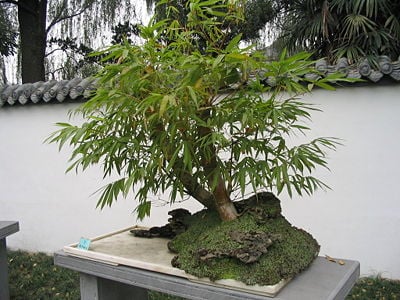
Several Asian cultures, including that of the Andaman Islands, believe that humanity emerged from a bamboo stem. In the Philippine creation myth, legend tells that the first man and the first woman were split open from a bamboo stem that emerged on an island created after the battle of the elemental forces (Sky and Ocean). In Malaysian legends, a similar story includes a man who dreams of a beautiful woman while sleeping under a bamboo plant; he wakes up and breaks the bamboo stem, discovering the woman inside. The Japanese folktale "Tale of the Bamboo Cutter" (Taketori Monogatari) tells of a princess from the Moon emerging from a shining bamboo section. Hawaiian bamboo ('ohe) is a kinolau or body form of the Polynesian creator god Kāne Milohai.
An ancient Vietnamese legend tells of a poor, young farmer who fell in love with his landlord's beautiful daughter. The farmer asked the landlord for his daughter's hand in marriage, but the proud landlord would not allow her to be bound in marriage to a poor farmer. The landlord decided to foil the marriage with an impossible deal; the farmer must bring him a "bamboo tree of one-hundred sections." The benevolent god Bụt appeared to the farmer and told him that such a tree could be made from one-hundred sections from several different trees. Bụt gave to him four magic words to attach the many sections of bamboo: "Khắc nhập, khắc xuất," which means "put in immediately, take out immediately." The triumphant farmer returned to the landlord and demanded his daughter. The story ends with the happy marriage of the farmer and the landlord's daughter.
Science
The Song Dynasty (960-1279 C.E.) Chinese scientist and polymath Shen Kuo (1031-1095) used the evidence of underground petrified bamboo found in the dry northern climate of Yan'an, Shanbei region, Shaanxi province to support his geological theory of gradual climate change (ICHSEA 2003; Needham 1986).
Taxonomy of Bambuseae
The tribe Bambuseae comprises around 1,000 species, distributed into numerous tribes, subtribes and about 91 genera:
Subtribe Arthrostylidiinae
It comprises 12 genera:
- Actinocladum
- Alvimia
- Arthrostylidium
- Athroostachys
- Atractantha
- Aulonemia (Matudacalamus)
- Colanthelia
- Elytrostachys
- Glaziophyton
- Merostachys
- Myriocladus
- Rhipidocladum
Subtribe Arundinariinae
It comprises 17 genera:
- Acidosasa
- Ampelocalamus
- Arundinaria
- Borinda
- Chimonocalamus (Sinarundinaria)
- Drepanostachyum
- Fargesia
- Ferrocalamus
- Gaoligongshania
- Gelidocalamus
- Himalayacalamus
- Indocalamus
- Oligostachyum
- Pseudosasa
- Sasa
- Thamnocalamus
- Yushania
Subtribe Bambusinae
It comprises 10 genera:
- Bambusa (Dendrocalamopsis)
- Bonia (Monocladus)
- Dendrocalamus (Klemachloa, Oreobambos, Oxynanthera, Sinocalamus)
- Gigantochloa
- Dinochloa
- Holttumochloa
- Kinabaluchloa (Maclurochloa, Soejatmia)
- Melocalamus
- Sphaerobambos
- Thyrsostachys
Subtribe Chusqueinae
It comprises 2 genera:
- Chusquea (Dendragrostis, Rettbergia)
- Neurolepis (Planotia)
Subtribe Guaduinae
It comprises 5 recognized genera:
- Apoclada
- Eremocaulon (Criciuma)
- Guadua
- Olmeca
- Otatea
Subtribe Melocanninae
It comprises 9 genera:
- Cephalostachyum
- Davidsea
- Leptocanna
- Melocanna (Beesha)
- Neohouzeaua
- Ochlandra
- Pseudostachyum
- Schizostachyum
- Teinostachyum
Subtribe Nastinae
It comprises 6 genera:
- Decaryochloa
- Greslania
- Hickelia
- Hitchcockella
- Nastus
- Perrierbambus
Subtribe Racemobambodinae
It comprises 1 genus:
- Racemobambos (Neomicrocalamus, Vietnamosasa)
Subtribe Shibataeinae
It comprises 9 genera:
- Brachystachyum
- Chimonobambusa
- Indosasa
- Phyllostachys
- Qiongzhuea
- Semiarundinaria
- Shibataea
- Sinobambusa
- Temburongia (incertae sedis)
ReferencesISBN links support NWE through referral fees
- Bystriakova, N., V. Kapos, I. Lysenko, and C. M. A. Stapleton. 2003. Distribution and conservation status of forest bamboo biodiversity in the Asia-Pacific Region. Biodiversity and Conservation 12 (9): 1833-1841. Retrieved August 24, 2007.
- Huberman, M. A. 1959. Bamboo silviculture. Unasylva 13(1). Retrieved July 7, 2007.
- International Conference on the History of Science in East Asia (ICHSEA), A. K.-L. Chan, G. K. Clancey, and H.-C. Loy. 2003. Historical Perspectives on East Asian Science, Technology, and Medicine. Singapore: World Scientific. ISBN 9971692597.
- Lela Designs. 2007. Fabric facts and questions. Lela Designs. Retrieved July 5, 2007.
- Needham, J., P. Y. Ho, G.-D. Lu, and L. Wang. 1986. Science and Civilization in China. Volume 3: Mathematics and the Sciences of the Heavens and the Earth. Taipei: Caves Books.
- Puri, H. S. 2003. Rasayana Ayurvedic Herbs for Longevity and Rejuvenation. London: Taylor & Francis. ISBN 0203216563.
- United States Department of Agriculture (USDA). 2007. Arundinaria gigantea' (Walt.) Mulh. giant cane. PLANTS Profile. Retrieved July 5, 2007.
Credits
New World Encyclopedia writers and editors rewrote and completed the Wikipedia article in accordance with New World Encyclopedia standards. This article abides by terms of the Creative Commons CC-by-sa 3.0 License (CC-by-sa), which may be used and disseminated with proper attribution. Credit is due under the terms of this license that can reference both the New World Encyclopedia contributors and the selfless volunteer contributors of the Wikimedia Foundation. To cite this article click here for a list of acceptable citing formats.The history of earlier contributions by wikipedians is accessible to researchers here:
The history of this article since it was imported to New World Encyclopedia:
Note: Some restrictions may apply to use of individual images which are separately licensed.



